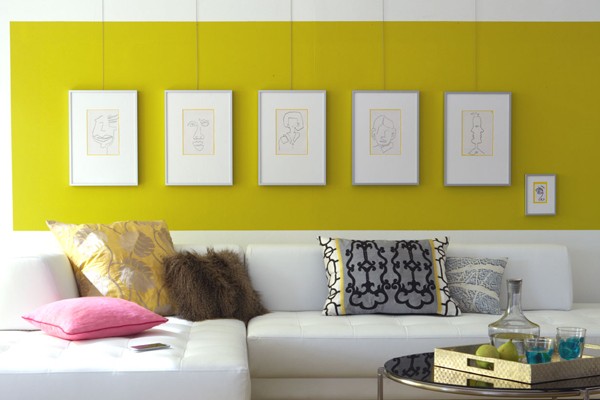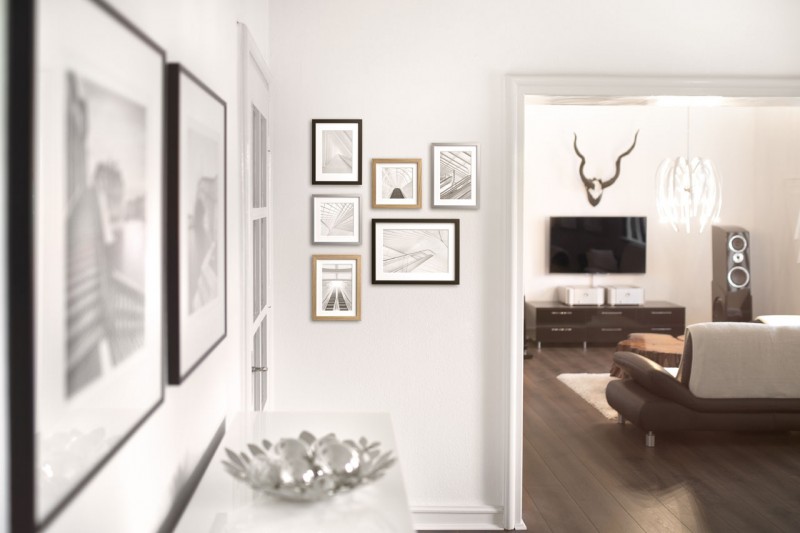HANGING PICTURE FRAMES STYLISHLY - THIS IS HOW IT WORKS
Arrangements of picture frames for your wall design
„A picture is only completed when it has found its place on the wall.“
While the actual hanging is easy to handle (with nails, screws or gallery rails), creativity is required for the wall design as well as for the picture design. Nevertheless, there are design grids that provide orientation. As with the construction of a picture, there are basic rules of line, from which one may deviate in artistic freedom.
No matter whether it is a single hanging, block hanging or salon style hanging, in the following we will introduce you to some basic rules and show you successful examples so that you can find the perfect hanging for you and your home or gallery receives a unique ambience.
The choice of the best picture frame has a decisive influence on the effect of the picture. It presents the artistic value appropriately and draws a visible line between the wall and the work. Just as important is the design and presentation on the wall. The arrangement influences the viewer's perception. It creates connection or draws clear boundaries. In this way, the viewer's gaze and attention can be directed visually.
The other way around, the pictures and their arrangement create a certain character in the room. „It is crucial to create a harmonious relationship between picture, picture frame, wall and space.“
With single pictures the middle is to be attached on 1,55m ( eye-level ) over the ground, often the only rule, which one should heed. In the case of several pictures or in exhibitions, however, special attention must be paid to the design. The ideal wall design depends on the motif, its message, the room, the furniture and of course your own taste.
In the following we explain the basic approaches of the different types of hanging and present them in detail.
There are two basic approaches to why and how a picture is hung. Either it is a single picture or a picture series, for which the best place should be found, or the other way around: a room should be beautifully designed and the matching pictures, as well as the perfect hanging must be found.
1. The focus is on the picture
In this case the motif, the size and often also the picture frame are already known. Here the picture or the pictures are in the foreground and should be presented appropriately. In other words, it is the focus of attention and should be an eye-catcher. For this it is to be noted that it, or the group, should hang for itself and centrally, with enough free wall space around it. However, a wall must not be too large, so that the picture could be lost on it. This gives the picture the perfect stage and the view is directed to the motif. Connected series are often hung as a group at a small distance from each other to create a visual connection.
2. The interior design counts
Here the approach is different. The room itself is the focus and the goal is to fill white walls in an appealing way, because hardly anything influences the character of a room as much as pictures and their arrangement. If the furniture is minimalistic and clear, the wall should not be overloaded - less is more here. In filled rooms, the wall may also be filled. If "the picture" for the room is searched and found, we are again at "picture in the centre". Otherwise, multi-part hangings with several pictures of different sizes and motifs are also suitable, here may be combined according to desire and mood.
Find the right place for your pictures. Pictures should of course hang where they are well seen. A picture or a group hanging should not be too small and not too big for the wall. If it is too small, it will sink onto the wall and will appear lost. With a large passepartout and thus a larger picture frame you can give the pictures more size, but there are limits to the trick somewhere. If the wall is too small, i.e. the free space next to the frame towards furniture, doors or corners is too small, it seems squeezed. Then another place should be found.
Light in particular has a strong influence on perception. It influences the power of colour and sharpness of detail. Ideally, uniform and diffuse lighting should be used to avoid dark corners. When accentuating with spotlights, pay attention to the shadows cast at the top edge.
When placing directly opposite windows, the choice of glass must be taken into account in order to avoid reflections. Direct sunlight should be avoided to protect the picture from UV rays, if it cannot be avoided, the picture frame glass must have a high UV protection, especially with originals.
Ideally, the wall color is neutral, so you have the most options in wall design.
It is best to visualize your design ideas before the first hole is drilled.
Rows and especially the distances between the pictures can be tested well when the pictures are leaned against the wall. Place something underneath to avoid scratching the frame, floor or furniture.
Groups can first be positioned on the floor and arranged in such a way as to create a harmonious overall picture. Alternatively, different digital designs can also be created.
The best impression is made with suitable sized papers that are fixed to the wall with a painter's tape.
You have several options for the design and arrangement of the pictures. Depending on the preference and style of the room, you can choose an orderly hanging with clear and strict lines, or you can choose a random, chaotic hanging that gives the room a certain charm.
No matter which hanging you decide on, every possibility - if correctly installed - will result in a harmonious and stylish overall result. In the first step, you basically differentiate between the types of design and whether you want to attach a single picture or a group of pictures to the wall. Depending on the type of hanging, there are also different variants. While a single picture is placed where it works best, with several pictures you have to pay attention to the connection and the perfect interaction, because groupings create an optical coherence.
It should be noted that the human eye likes clear lines and symmetries. For this reason, many design guides are based on primarily horizontal or vertical lines. These rules are always relevant, but of course nothing stands in the way of artistic freedom. In the following, we have compiled the most popular types of design for picture hanging.
The different design rules can be combined with each other wonderfully, so that you can realize loose, but at the same time ordered wall coverings, which are interesting for the viewer to look at and arouse his interest. In addition to the choice of the ideal picture frame, the wall design has a very important influence on the effect of the picture. Especially at exhibitions, one should pay as much attention to the arrangement as to the choice of the motifs themselves.

© Walter Schels

Picture frames are particularly suitable for wall design in stairwells. Here several pictures can be arranged creatively and impressively. Here the axis follows through the middle of the pictures along the ascent of the stairs.
But picture frames also have an impressive effect as an independent design element.
Note from our side:
On the one hand, we are pleased that in many living ideas empty picture frames are also used as decorative elements. But a framed picture is even more beautiful.
© Miki Lin
- If you decide in advance on certain/connected motifs, the selection of the design type is made easier for you.
- Examine the place of the hanging more closely in advance: if the lighting conditions are ideal, how does the hanging appear later with regard to furnishings and walls?
- Align the main picture of the hanging at eye level (1.55m) and arrange the remaining frames around this picture.
- Test the arrangement on the floor in advance, or place cartons in the appropriate format to find the correct arrangement.
We hope that with these tips and tricks we have been able to give you some inspiration for your wall design and wish you lots of fun while hanging it up.














